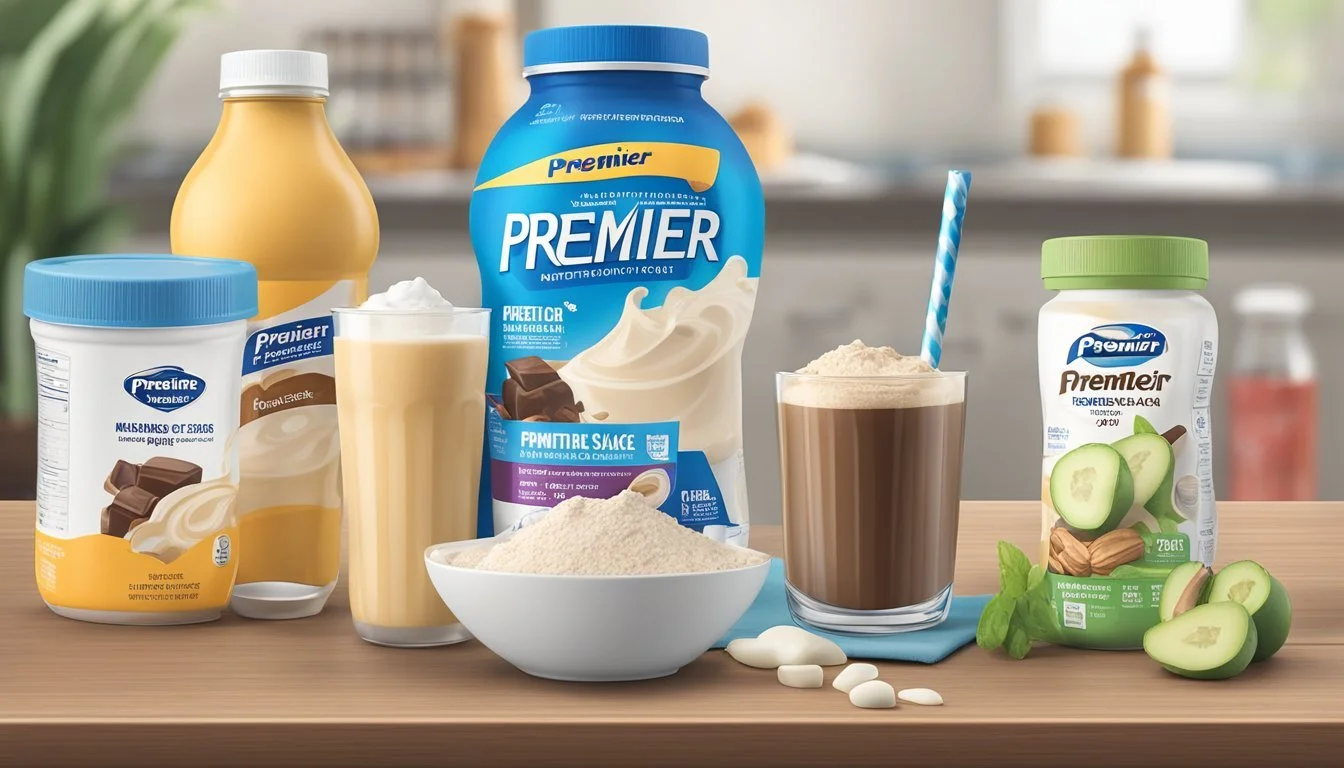How Many Servings of Premier Protein Shake Is Too Much
Expert Guidelines
Premier Protein shakes offer a convenient way to boost protein intake, featuring 30 grams of protein in each 11.5 oz. bottle with just 160 calories and minimal sugar. While these shakes can be beneficial for muscle growth and daily protein needs, it's crucial to understand the appropriate serving size to avoid overconsumption.
Most people should stick to one or two Premier Protein shakes a day. This recommendation ensures they get enough protein without surpassing their daily nutritional needs. Consuming more than this can lead to an excess which may strain the kidneys and contribute to other health issues.
It's essential to balance protein supplements with whole foods to ensure a well-rounded diet. While Premier Protein shakes provide a quick and easy protein source, they should complement rather than replace other nutrient-dense foods.
Understanding Protein Shakes
Protein shakes are popular for their convenience and benefits in muscle growth and recovery. Each shake typically contains various ingredients that offer essential nutrients for the body.
Components of Protein Shakes
Protein shakes consist of protein powders, liquids like milk or water, and sometimes additional ingredients such as sweeteners and flavorings. The primary component is protein, which can be derived from sources like whey, casein, soy, or pea protein. These shakes also often contain carbohydrates, fats, and a range of vitamins and minerals necessary for overall health. The addition of sucralose or other sweeteners helps enhance taste without adding sugar.
The Role of Protein in the Body
Protein plays a crucial role in muscle growth, repair, and recovery. It provides the amino acids needed for muscle protein synthesis, a process where muscle fibers are rebuilt stronger after exercise. Protein also regulates numerous bodily functions, boosts energy levels, and aids in maintaining a healthy immune system. When consuming protein shakes, it's essential to balance them with other nutrients to avoid excessive calories intake.
Types of Protein in Shakes
The main types of protein found in shakes include whey protein, casein, soy, and pea protein. Whey protein is a fast-digesting protein popular for post-workout recovery. Casein protein digests slower, making it ideal for sustained protein release. Soy protein is a complete protein derived from plants and is a good option for those avoiding dairy. Pea protein is another plant-based option, suitable for vegans and individuals with allergies to dairy or soy.
Each type of protein offers different benefits and amino acid profiles, catering to varied dietary preferences and needs.
Daily Protein Requirements
Protein requirements vary significantly based on age, activity level, and overall health. An understanding of these factors can help individuals determine their optimal protein intake and make informed decisions regarding protein supplements like Premier Protein Shakes.
Protein Needs by Age and Activity Level
Daily protein needs differ by age and activity level. Adults typically require about 0.8 grams of protein per kilogram of body weight. For example, a 70kg adult would need around 56 grams of protein daily. Active individuals and athletes often need more, roughly 1.3 to 1.8 grams per kilogram of body weight, to support muscle mass and recovery from exercise.
Women and girls (14+): 46 grams/day
Men (19+): 56 grams/day
Athletes: Up to 126 grams/day for a 70kg person
Comparison With Whole Foods
Protein from whole foods provides additional nutrients that supplements may lack. Chicken, eggs, and nuts are high in protein and contain essential vitamins and minerals. For instance, a cooked chicken breast (100g) offers about 31 grams of protein along with B vitamins and minerals like selenium.
Protein sources:
100g chicken breast: ~31 grams protein
1 large egg: ~6 grams protein
28g almonds: ~6 grams protein
Choosing whole foods helps ensure a balanced intake of macronutrients and supports overall dietary goals. Solid foods also provide fiber, healthy fats, and other essential nutrients. Protein shakes, while convenient and high in protein, may not fully substitute for the diverse benefits offered by natural food sources.
Premier Protein Shake Overview
Premier Protein Shakes are popular for their high protein content and convenience. They provide a substantial nutritional profile while also raising some concerns regarding ingredients and daily consumption limits.
Nutrition Facts and Ingredients
Premier Protein Shakes contain 160 calories per 11.5 oz serving. Each shake offers 30 grams of protein, 5 grams of carbohydrates, 3 grams of fiber, and 1 gram of total sugar with no added sugar.
These shakes are enriched with essential vitamins and minerals. Common ingredients include milk protein concentrate, cocoa powder, and sweeteners such as sucralose. They also contain preservatives to maintain shelf life. The nutrient balance makes them a substantial supplement for those needing increased protein intake.
Advantages and Conveniences
These shakes are designed for individuals seeking a quick and easy protein source. Their high protein content aids in muscle repair and growth, making them ideal for athletes and gym-goers. They can also serve as a meal replacement due to their balanced nutrients.
The low sugar content is beneficial for those monitoring their sugar intake. Furthermore, the convenience of pre-packaged shakes allows for easy consumption on the go. The portability and ready-to-drink format are primary selling points for busy individuals.
Potential Concerns
While Premier Protein Shakes offer numerous benefits, certain issues need attention. The presence of processed ingredients and sweeteners like sucralose might be a concern for those preferring whole, unprocessed foods.
Additionally, there are dairy-based components, making them unsuitable for individuals with lactose intolerance or dairy allergies. It's crucial to adhere to recommended daily intake limits, generally 1-2 shakes, to avoid excessive protein consumption, which can strain the kidneys.
Understanding these factors helps in making an informed decision about incorporating Premier Protein Shakes into one's diet.
Determining Safe Consumption Levels
Determining how many servings of Premier Protein Shake is safe requires balancing individual protein needs with health guidelines. Factors such as body weight, activity level, and possible health risks play crucial roles.
Guidelines from Health Authorities
Health authorities like the FDA recommend different protein intakes for various demographics. For example, women ages 14 and up need 46 grams of protein per day, while men need 56 grams.
In addition, registered dietitians suggest that healthy individuals consume about 0.8 grams of protein per kilogram of body weight. Athletes may need up to 1.8 grams per kilogram to meet their heightened nutritional demands. Consuming one to two Premier Protein Shakes daily aligns with these guidelines for most people, providing a balanced addition to other dietary sources of protein.
Risks of Excessive Protein
Consuming an excessive amount of protein, especially through supplements like Premier Protein Shakes, can lead to various health issues. The kidneys and liver, which help process protein, can experience stress and potential damage due to high intake levels.
Additionally, the risk of dehydration increases as the body requires more water to process the increased protein. Excessive protein consumption can also have cardiovascular implications like increased risk of heart disease. It's important to regularly consult with a doctor or registered dietitian to ensure safe levels, especially if consuming multiple protein shakes daily.
Signs of Overconsumption
Recognizing the signs of too much protein intake is crucial for maintaining health. Symptoms of overconsumption can include bloating, digestive issues, and nausea. Persistent bad breath is another indicator, often caused by the body entering a state of ketosis due to insufficient carbohydrates.
Long-term, excessive protein can lead to more severe conditions, such as kidney stones or liver dysfunction. Monitoring for these signs and adjusting protein intake accordingly helps mitigate negative side effects. If any symptoms appear, it’s advisable to consult a healthcare professional immediately to evaluate dietary habits and overall health.
Optimizing Protein Intake for Health and Fitness
Achieving optimal health and fitness involves careful management of protein intake. This includes considering the timing of protein consumption, the balance between supplements and whole foods, and specific dietary needs.
Timing and Distribution
Proper timing and distribution of protein intake can enhance muscle recovery and growth. Consuming protein shakes post-workout helps replenish glycogen stores and aids in muscle repair.
Spreading protein consumption evenly throughout the day ensures continuous muscle protein synthesis. A typical recommendation is to consume 20-30 grams of high-quality protein per meal. This can be achieved through a mix of protein shakes and whole foods like lean meats, beans, and dairy.
Hydration is also crucial as it supports overall muscle function and recovery.
Supplementation vs. Whole Foods
Protein shakes offer a convenient option for boosting daily protein intake. They are particularly useful for those with strict dietary schedules or elevated protein needs, such as athletes in heavy training.
Whole foods provide additional nutrients such as fiber, carbs, and healthy fats that are essential for a balanced diet. Examples include eggs, fish, nuts, and legumes.
For sustained energy and overall health, combining both protein shakes and whole foods ensures a diverse nutrient profile.
Special Considerations for Diets
Different diets require personalized protein strategies. Vegetarian and vegan diets can meet protein needs through plant-based sources like beans, lentils, tofu, and quinoa.
Individuals aiming for weight loss can benefit from high-protein meals that promote satiety, reducing overall calorie intake. Those targeting muscle gain should focus on adequate protein paired with carbs for energy during workouts.
Special dietary considerations might also include selecting protein supplements free from allergens or additives. Keeping dietary preferences and restrictions in mind is key to optimizing protein intake for overall health and fitness goals.






